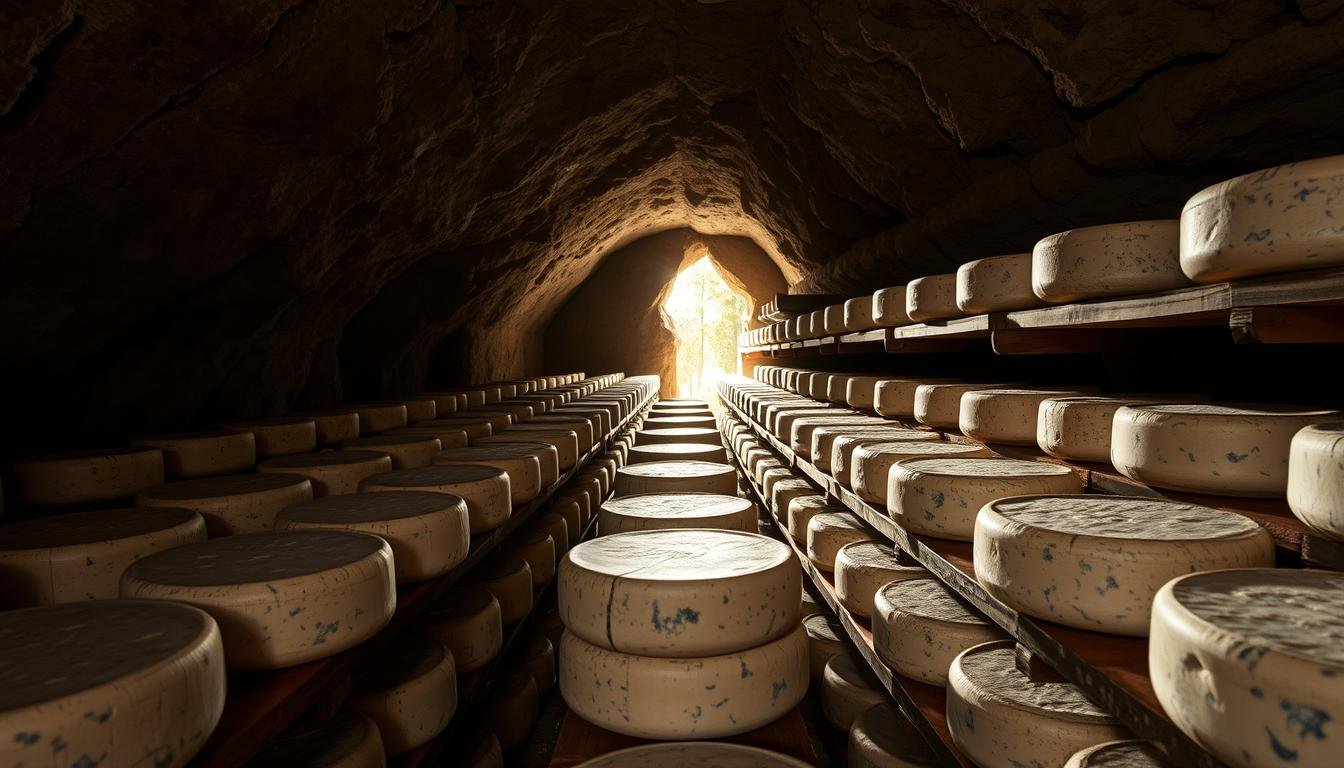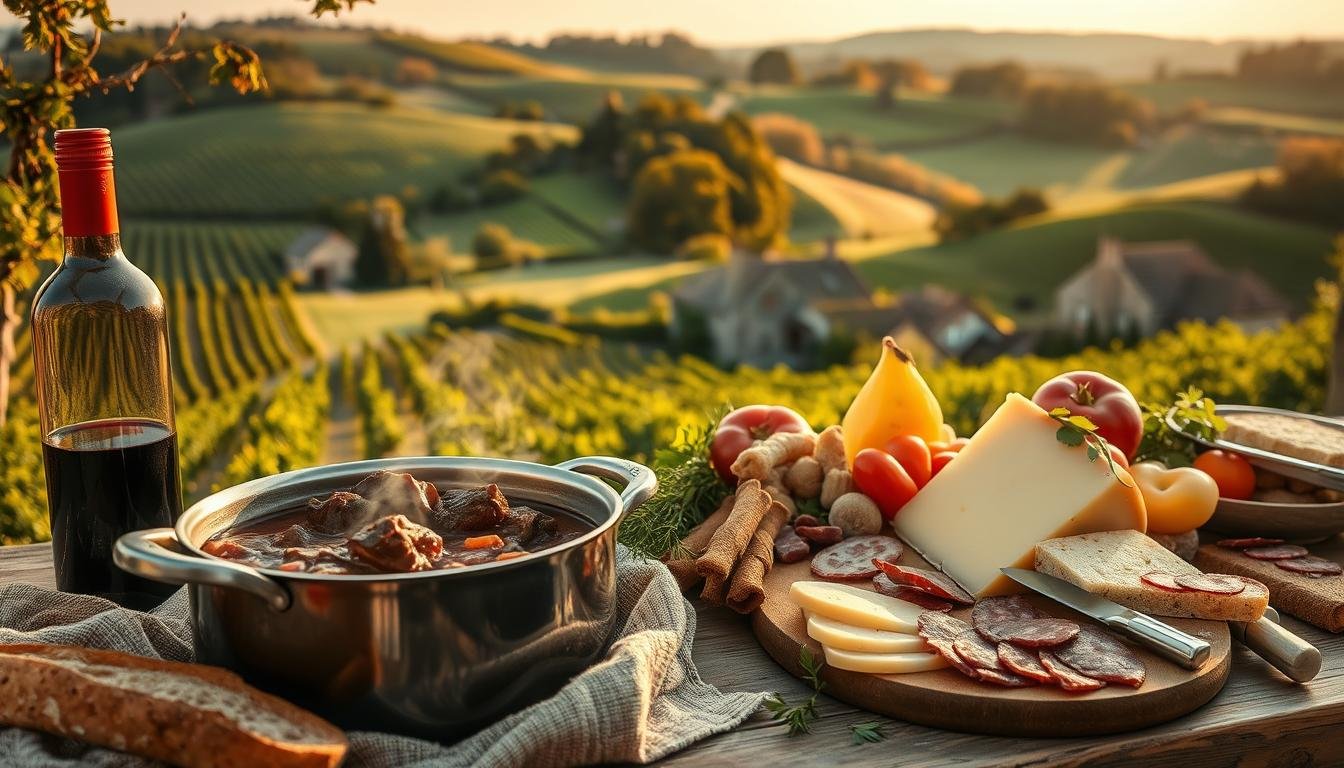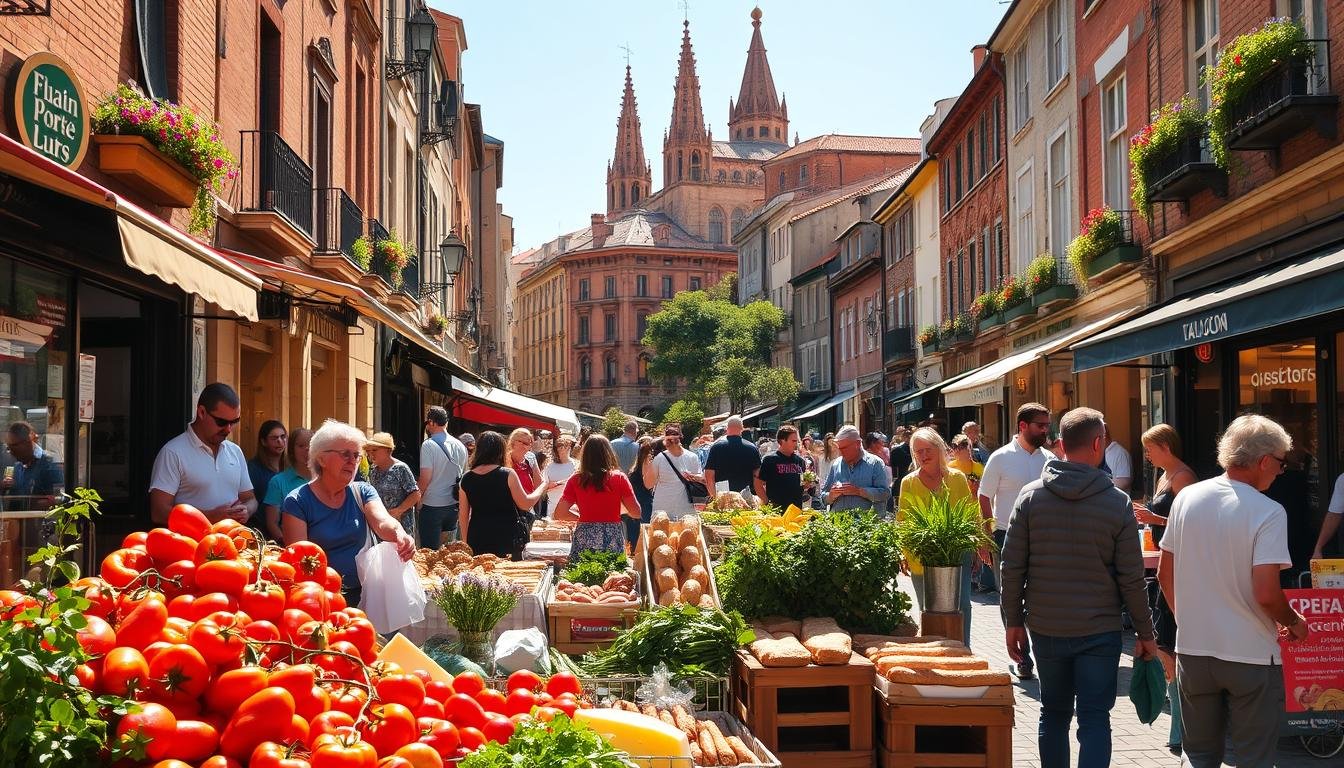Roquefort cheese is found in southern France’s limestone cliffs. Its first taste was a surprise—its sharpness and creaminess told a story of tradition. This guide takes you through how aging in Combalou caves turns sheep’s milk into a historical flavor.
Roquefort’s story goes beyond its taste and the mold that makes it. It’s about the landscapes and each wheel’s tale. Enjoyed on crackers or melted, it shows France’s love for food. For more, check out the gourmet cheese guide to learn about its Protected Designation of Origin.
Key Takeaways
- Roquefort cheese’s distinctive blue veins form naturally in Combalou caves, defining its creamy texture and sharp flavor.
- Its Protected Status requires use of raw sheep’s milk from specific regions, honoring centuries-old methods.
- Pairing this French blue cheese amplifies its complexity, from sweet dessert wines to hearty salads.
- Visiting Roquefort-sur-Soulzon offers a firsthand glimpse into its cultural and gastronomic heritage.
- Every wheel reflects the craftsmanship of affineurs who perfect its aging process over 3 months.
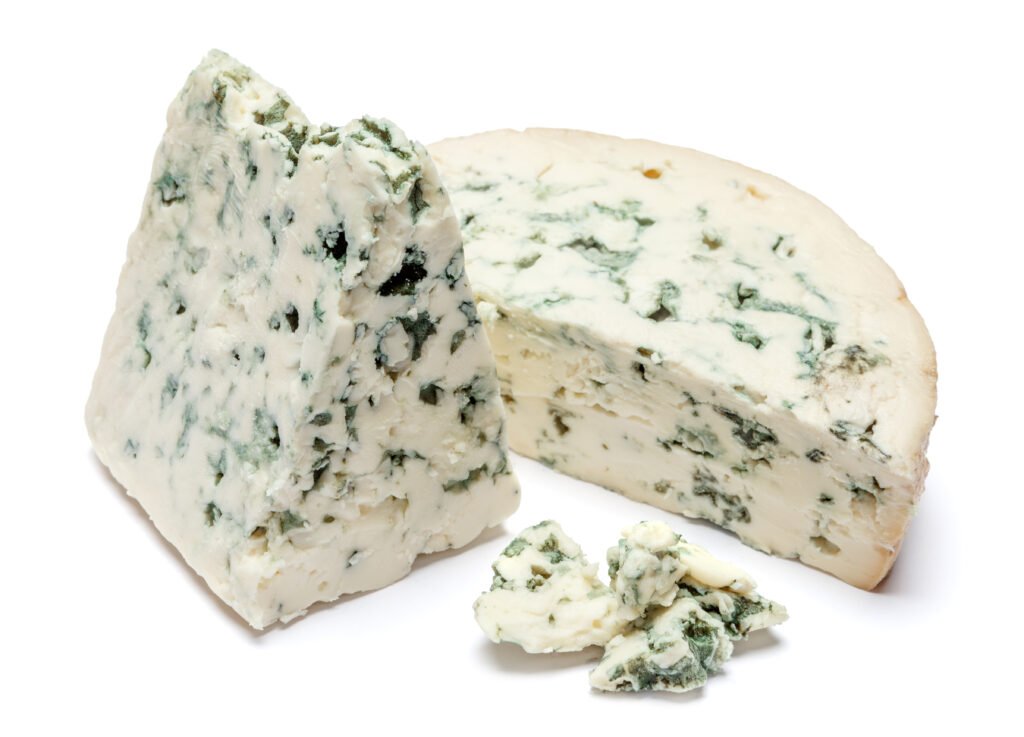
The Legendary Blue Cheese That Changed The World
My journey into Roquefort started with its history. This story is as rich as the blue veins in its cheese. The Roquefort history goes back to a shepherd’s discovery. He left bread and cheese in a cave, and months later, it was transformed by Penicillium roqueforti molds.
This legend, part of the French cheese origins, shows how chance and nature create culinary wonders.
The Shepherd’s Legend: How Roquefort Was Accidentally Discovered
The cave in Aveyron is sacred. Its cool, humid air nurtures the molds that turned cheese into a delicacy. Today, all real Roquefort ages in these caves, a tradition kept by law from 1411.
Why Roquefort Deserves Its Protected Status
In 1925, Roquefort became the world’s first PDO cheese. This status protects its production. Every wheel uses raw sheep’s milk from Lacaune sheep grazing on local pastures. This recipe has stayed the same for centuries.
Without PDO, its soul could be lost to industrial shortcuts.
My First Encounter with the King of Cheeses
My first taste of Roquefort was in a Parisian fromagerie. The salt-kissed rind gave way to a velvety interior with blue threads. Its tang was like a mountain breeze, then softened into a buttery finish.
That moment showed me why Roquefort’s heritage is important. It’s not just cheese; it’s a living heritage.
The Magical Combalou Caves: Nature’s Perfect Cheese Cellar
Stepping into the Combalou caves feels like a journey back in time. The air is cool and misty as you go down into the limestone cliffs. For centuries, these caves have aged Roquefort cheese.
My flashlight showed me shelves full of cheese. The blue veins in the cheese glowed softly in the dark. It was a sight as old as the caves.
Every part of these caves has a story. The walls keep a steady 10°C (50°F) and 90% humidity. This is as good as any modern climate control.
Natural vents called fleurines help the cheese age. They guide spores to make the cheese blue. This mix of nature and science makes Roquefort unique.
Looking at the cheese, I was amazed by its journey. Each wheel ages for 90 days, getting sharper and more complex. The caves are not just for aging cheese; they’re a tradition.
My guide said, “This is where the cheese becomes Roquefort.” It felt like a sacred moment. These caves are more than aging places; they show how nature and human skill come together.
Culinary Tour of Roquefort France: An Unforgettable Gastronomic Adventure
Roquefort-sur-Soulzon lies beneath the Combalou cliffs, a village with ancient traditions. A Culinary Tour of Roquefort France takes you through cobblestone paths and aging cheese cellars. The air is filled with the scent of penicillin and earth, making it a journey for the senses.

Planning Your Visit to Roquefort-sur-Soulzon
Spring or autumn is the best time to visit. The French gastronomy tours are less crowded then. Stay in chambres d’hôtes like Maison des Caves or Le Roc Saint-Clair for a local experience.
Bring sturdy shoes for hikes to the grottes. Don’t forget a journal to write down your experiences.
The Best Cheese Tours in the Region
| Tour | Highlight | Why Book |
|---|---|---|
| Société Cheese Cellar Tour | Guided cave visits with tasting flights | Witness 800-year-old aging techniques |
| Papillon’s Artisan Workshop | Hands-on rind-touching sessions | Small-group intimacy |
| Gabriel Coulet’s Heritage Trail | Historical reenactments of 12th-century production | Unmatched storytelling |
Beyond Cheese: Local Delicacies to Discover
- Marcillac wine’s honeyed tannins paired with walnut-infused honey
- Aligot—pasta-like dish of melted Roquefort and garlic purée
- Black truffle tarts from market stalls in Saint-Affrique
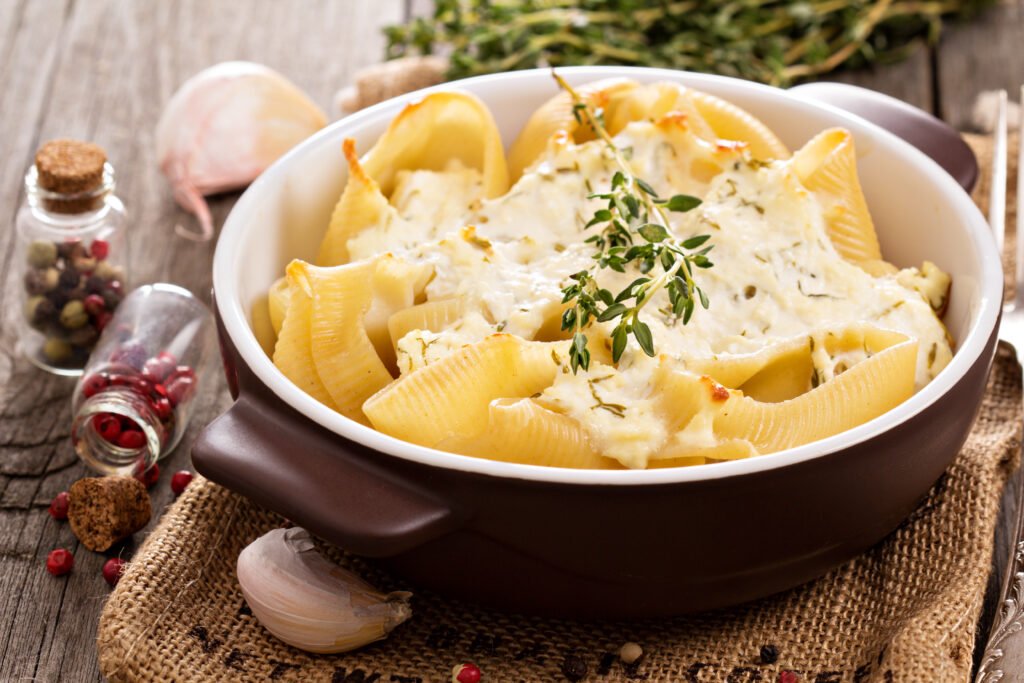
“The best aligot is stretched like taffy between two spoons,” said my guide at L’Auberge du Fromage. I learned to fold the cheese into the pasta until it became a silky blanket.
Explore the mix of tradition and innovation in Roquefort. Each bite tells a unique story.
The Artisanal Process: Why No Two Wheels of Roquefort Are Identical
Walking through the Combalou caves, I saw how each Roquefort wheel is unique. The magic of artisanal cheese making starts with Lacaune sheep eating different plants. This changes the milk’s taste, making every batch special.
The Role of Penicillium Roqueforti
At the core of this craft is Penicillium roqueforti, a mold grown on rye bread for centuries. Cheesemakers use needles to introduce the mold into each wheel. They say,
“The mold dances differently each season—it’s a partner, not a slave to our hands.”
This dance turns milk into the blue veins that make Roquefort special.
The Affinage Masters: Guardians of Tradition
These experts turn wheels every week, removing mold by hand. Their skill in balancing flavors is learned over time. The caves, shaped by water, help create the cheese’s unique taste. Pairing Roquefort’s complexity shows the importance of this process.
- Seasonal milk variations from Lacaune flocks
- Microclimate nuances in different cave sections
- Human intuition guiding maturation timelines
These factors come together to create a tradition that values uniqueness. Tasting Roquefort is like tasting time, shaped by hands that celebrate imperfection.
Tasting Notes: Decoding the Complex Flavors of Roquefort
When you open a Roquefort, take your time. Let it sit at room temperature until it’s ready. Feel its texture and smell its aroma, which changes from strong to earthy.
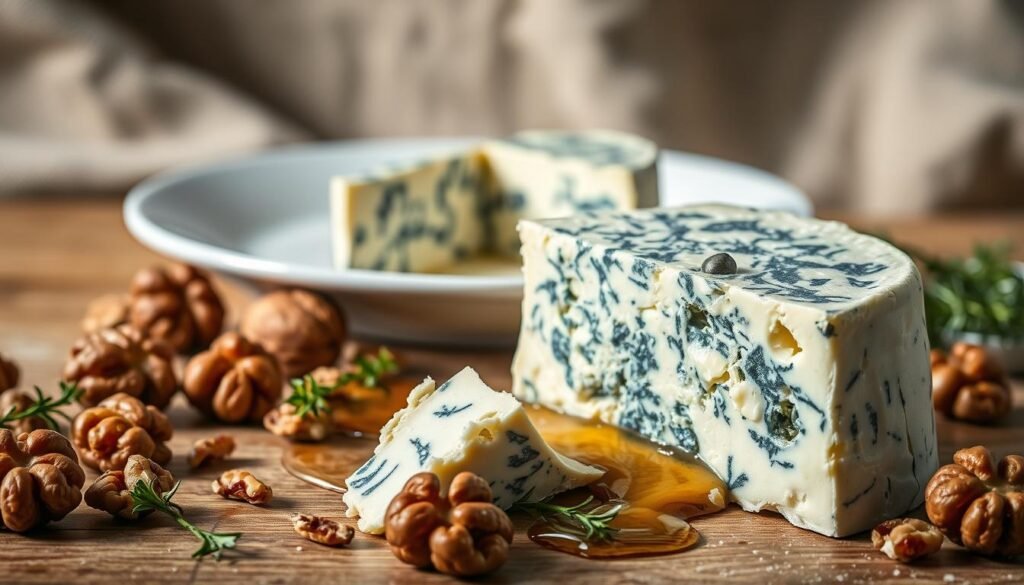
Hélène from the Société des Propriétaires des Caves de Roquefort taught me to taste like a scientist. The first taste is salty and sharp. Then, the cheese becomes creamy and tastes like walnuts or caramel.
Some Roqueforts even taste like truffles or have a smoky finish. This finish stays with you, like a great story.
“Taste is memory,” Hélène insists. “Every bite connects you to the Combalou caves where Penicillium roqueforti first danced with sheep’s milk.”
Roquefort’s flavors are both salty and sweet. Young cheeses are tangy, while older ones taste like forest and chocolate. The cheese’s moisture affects its texture, making some dry and others creamy.
When you taste Roquefort, let your senses explore. Is it the minerality of Laguiole sheep’s milk or the sweetness of an affineur’s touch? Roquefort is complex, like a language to learn.
The Perfect Pairings: Elevating Roquefort Beyond the Cheese Board
My journey with Roquefort has been a dance of discovery. Each bite invites me to explore new flavors. The classic pairing of Roquefort with Sauternes is amazing. But, there’s more to discover.
Wine Companions: From Sweet Sauternes to Bold Reds
- Sauternes: The sweet, golden nectar cuts Roquefort’s sharpness like sunlight through fog.
- Cahors Malbec: A bold red that stands up to the cheese’s pungency.
- Walnut aperitif: A local specialty that adds earthy depth.
Unexpected Pairings That Changed My Mind
Smoky Japanese whisky and tangy pear cider can elevate Roquefort. A 12-year-old Yamazaki paired with Roquefort was a game-changer. It showed me the power of unexpected flavors.
A mistake with bitter chocolate taught me a lesson. It showed me the importance of balance. Sweetness can counteract bitterness.
Cooking with Roquefort: Beyond the Obvious
| Roquefort Recipe | Highlight |
|---|---|
| Soufflé au Fromage | Air-light custard cradling chunks of Roquefort. |
| Steak Bordelaise | Serve with a béarnaise sauce spiked with Roquefort. |
| Poached Pears | Drizzle with Roquefort cream and caramelized walnuts. |

These recipes show Roquefort’s versatility. Try it with spiced apple cider or in gnocchi dough. Let your taste buds guide you.
How Roquefort Compares to Other World-Class Blue Cheeses
I’ve traveled far, tasting blues from France to Oregon. Each cheese has its own story. This blue cheese comparison shows how Roquefort meets global flavors.

Roquefort vs Stilton: A Franco-British Rivalry
In London, I saw how Stilton vs Roquefort debates excite people. Stilton has a rich, earthy taste from cow’s milk. Roquefort, made from sheep’s milk, is tangy and mineral.
Stilton’s caves are different from Roquefort’s. Stilton has a crunchy texture, while Roquefort is smooth. But both are perfect in their own way.
American Blue Cheese: New World Innovation
Sharing Rogue Creamery’s Oregon Blue in Paris was a hit. This American blue cheese uses local milk and tastes complex. Point Reyes’ bay blue adds a salty, briny flavor not found in Europe.
A Basque cheesemaker once said,
“These New World blues respect tradition while shouting their own truths.”
This innovation excites food lovers.
These cheeses are not rivals but friends, united by mold and soil. Each bite is a journey to new tastes.
The Cultural Significance of Roquefort in French Identity
Walking through Roquefort-sur-Soulzon, I’ve seen Roquefort is more than cheese. It’s a key part of French cheese culture and a defense against global flavors. Its food heritage shapes debates, laws, and family meals.
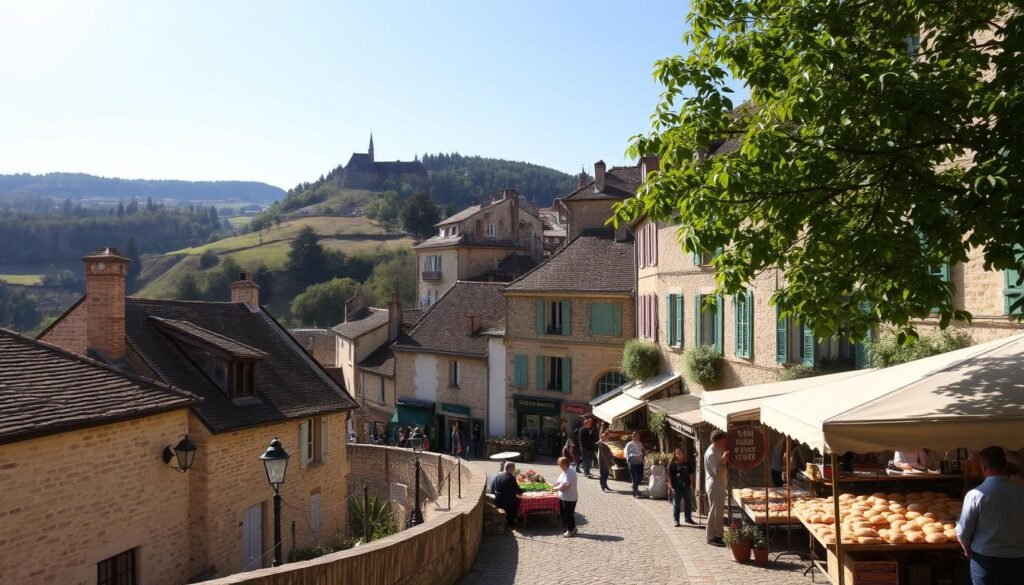
“This cheese is our defiance against plastic-wrapped ‘cheese products,’” explained one affineur, her hands brushing centuries-old cave walls. “It’s a promise we’ll never stop fighting for what’s real.”
In 1999, France used Roquefort as a weapon in culinary nationalism when it fought U.S. tariffs. Today, debates in Parliament show Roquefort’s importance. One legislator said it’s “the DNA of our culinary soul.”
- Artisan producers refuse automation, insisting hand-salting honors ancestral methods
- Every wheel’s blue veins symbolize resistance to industrialization
- Schoolchildren learn Roquefort’s AOC laws in history classes
At a village market, an elderly vendor gave me a wedge wrapped in food heritage. He said, “This is how my grandfather survived war. It’s not cheese—it’s memory.” This shows France’s fight to keep tradition alive while moving forward. When you taste Roquefort, you taste centuries of history and determination.
Finding Authentic Roquefort in America: What to Look For
Looking for authentic Roquefort in America needs careful searching. My exploration in American specialty shops showed that the real deal can be found.
“The PDO seal is non-negotiable,” insists a New York affineur I met at Brooklyn’s Murray’s Cheese. “Without that red sheep logo, it’s not the real thing.”
Spotting the Real Deal in Specialty Shops
True authentic Roquefort has three signs:
- A foil-wrapped wheel with the AOC/PDO red sheep emblem
- Even blue veins through ivory paste
- A crumbly texture that shows natural aging
Top Online Outlets for Imported French Cheese
| Importer | Key Features | Trust Signals |
|---|---|---|
| Murray’s Cheese | Ships with dry ice for cold-chain integrity | 30+ years of French dairy expertise |
| Formaggio Kitchen | Curates PDO-certified wheels from Roquefort producers | Partners with aging caves in France |
| igourmet | Offers 24-hour temperature tracking during transit | Reputation for premium specialty food shopping |
Always ask sellers about their cold storage. The imported French cheese journey needs 35-45°F conditions. A 10°F change can affect its taste. My best find was in a Chicago shop that used GPS cold-chain monitors.
Why Traditional Food Preservation Methods Matter in Modern Gastronomy
Walking through the Combalou caves, I felt the weight of centuries of traditional food preservation techniques. These methods, perfected long before refrigeration, are more than relics—they’re living links to our culinary past. Today, artisanal producers age cheeses like Roquefort using methods that balance science and intuition. This shows that artisanal food production isn’t just nostalgia; it’s a blueprint for sustainable eating.
“Aging Roquefort isn’t preservation—it’s transformation,” said one affineur, her hands brushing the rind of a wheel.
- These methods prioritize biodiversity by relying on local microclimates and raw milk.
- They reject industrial shortcuts, ensuring each cheese carries its terroir’s fingerprint.
- Such practices align with the slow food movement, resisting mass-produced sameness.
When we savor Roquefort, we taste centuries of trial-and-error wisdom. The slow, deliberate pace of artisanal food production counters today’s rushed consumption. Visiting producers, I learned how patience—waiting for Penicillium to bloom just so—creates flavors no factory process can replicate. These traditions aren’t frozen in time; they’re evolving tools for combating food waste and homogenized diets.
Choosing Roquefort isn’t just about flavor—it’s a vote for systems that honor biodiversity. In a world of quick fixes, these ancient methods remind us that food worth savoring demands time, place, and care. The caves’ echoes teach us that preservation isn’t about stasis but dynamic balance—a lesson for modern kitchens seeking both innovation and integrity.
Conclusion: Why Every Cheese Enthuasiast Should Experience Roquefort at Its Source
Walking through the Combalou caves, I felt the heartbeat of tradition. The affineurs’ hands traced veins of Penicillium Roqueforti, revealing a story of land and legacy. Culinary tourism here is more than a trip; it’s a dialogue with history.
To taste Roquefort elsewhere is to know its power. But to stand where it’s born is to understand its soul. Roquefort-sur-Soulzon transforms food into a travel experience. The tang of sheep’s milk and the earthy scent of caves are unforgettable.
Every tour here is filled with pride. These details vanish in a grocery store. They demand presence. This is where tradition breathes, connecting every crumb to a story of shepherds, monks, and penicillium spores.
My visit reshaped my view of culinary pilgrimages. Savoring Roquefort in its birthplace honors the hands and heritage behind it. For those seeking deeper meaning in food journeys, Roquefort invites you to taste place itself. Plan your journey via Epicurean-escape’s curated itineraries, designed to immerse you in its layers.
Culinary tourism at its best bridges cultures, one bite at a time. Roquefort’s story reminds us that every great cheese is a map. Follow its trail to its source, and let it guide you to the heart of why we eat: to feel alive in the places that shape our flavors.
